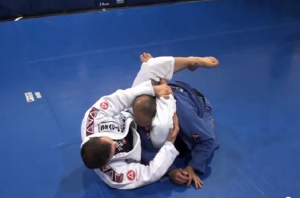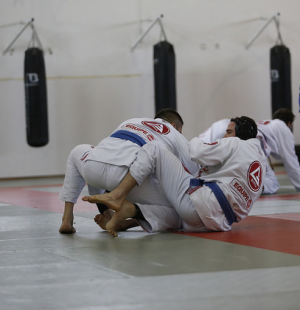The Dirty Dozen
The 12 Most Important Techniques For You To Learn When Your Start BJJ
Out of thousands of bjj techniques on YouTube, which select few should a student beginning their study of bjj focus on?It is not uncommon to feel overwhelmed not only with the technical details of each move, but how to select which ones are best to start with?!?
Here are the fundamental techniques that are most important for the beginning student.
* You will note that they are slanted heavily in the area of defense, as most student starting bjj need this the most.
Read also:3 Pieces of Advice for White Belts
1) Bottom side control: Guard replacement with hip escape, knee inside
Why?: You find yourself using this escape from your first roll all the way to when you are a black belt. You have to learn to move your hips on the bottom for all escapes.
 2) Guard: Scissors sweep
2) Guard: Scissors sweep
Why?: A classic technique that teaches you all of the elements to be used for all sweeps: break the balance, move your hips, create an angle, control grips. The scissors sweep combines very well with many other guard techniques in combination attacks.
3) Guard: Triangle choke
Why?: One of the signature submissions in bjj – works from white belt all the way to the highest levels of MMA and international competition, both gi and no-gi.
Learn how to use your legs to attack and choke your opponent.
4) Guard: Cross collar choke
Why?: The starting point for your sweeps and other attacks from the guard is the deep collar grip. This was Helio Gracie’s favorite move from the guard.
Teaches you how to use your grip to control your opponent and break their posture. It’s the starting point for your other guard attack combinations.
5) Bottom mount: Upa / Bridge and roll escape
Why?: Powerful hip bridges are the beginning to nearly all escapes on the ground. You learn to use the power of your hips and leverage to escape the mount – as opposed to pushing with straight arms (and getting armbarred) or worse… giving up your back!
 6) Bottom mount: Elbow to knee escape
6) Bottom mount: Elbow to knee escape
Why?: Along with #1 – “Guard replacement with hip escape, knee inside,” the elbow to knee escape is critical to learn to combine bridging and shrimping movements to escape bottom positions.
The first 2 years of training bjj you are going to need your escapes!
7) Top mount: Straight armlock
Why?: A classic submission from the dominant mount position. Teaches you how to isolate your opponent’s limb and apply the force of your entire body against their joint to get the tap.
This could be your first submission in live rolling!
8) Side control: Americana / Kimura locks
Why?: Side control teaches you to employ your weight to control an uncooperative opponent, and is a stable base from which to attack the shoulders with Americana and Kimura locks.
Learn the anatomy of the joints and how you can use leverage to force the opponent to tap.
9) Rear mount: Rear naked choke
Why?: The quintessential submission of bjj. The most dominant position in the jiu-jitsu positional hierarchy.
Especially against larger, stronger opponents and in a self defense situation. The most successful submission in the UFC.
 10) Pass the Guard: Over / under pass
10) Pass the Guard: Over / under pass
Why?: You need to have a plan when your opponent captures you in their closed guard. They will attack you and threaten with chokes, armlocks and triangles.
You need to get a safe posture and start to pass! This is the place for you to start learning to pass the guard.
11) Pass the Guard: Bull fighter pass
Why?: Your opponents will use many different styles of guard against you: not only closed guard.
The bullfighter pass teaches you to use your grips, side to side movement to avoid your opponents guard hooks and pass to side control.
Blackbelt world champions specialize in this style of pass and so should you!
12) Flying double reverse spinning berimbolo into gogoplata!
Why: Because it’s straight up Ninja!
Just kidding! The former 11 techniques will far better serve you in this early part of your training in bjj.
What are your most important fundamental techniques?
Read also: 3 Tips For Your First Year of Training
Credits: Mark Mullen
Gracie Barra Black belt based in Taipei, Taiwan
Twitter: @MarkMullenBJJ

